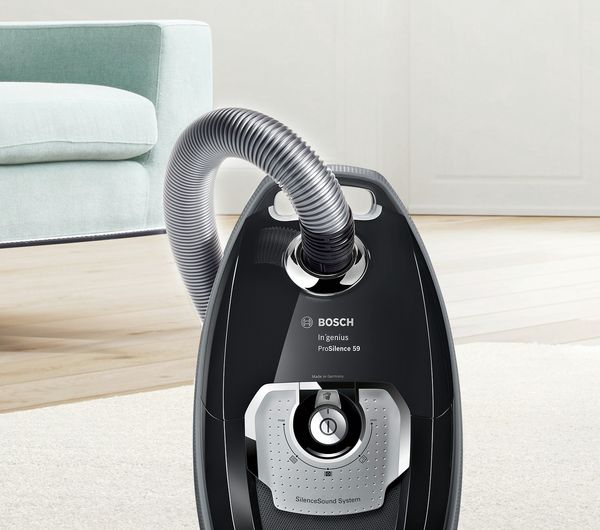Bosch vacuum cleaners are known for their quality and efficiency. But like any device, they can sometimes have issues.
Experiencing problems with your Bosch vacuum cleaner? Don’t worry, you’re not alone. Many users face common issues that can be easily resolved with a bit of troubleshooting. From power problems to unusual noises, understanding how to fix these can save you time and money.
This guide will help you diagnose and fix the most frequent Bosch vacuum cleaner issues. Whether it’s a minor glitch or a major fault, our tips will get your vacuum back in working order. Let’s dive into the common troubleshooting steps for your Bosch vacuum cleaner and get your cleaning routine back on track.
Common Issues
Dealing with a Bosch vacuum cleaner that doesn’t work can be frustrating. Understanding common issues can help you troubleshoot effectively. Below, we address two frequent problems: no power and loss of suction.
No Power
If your Bosch vacuum cleaner won’t turn on, check the power source first. Ensure the plug is securely in the outlet. Verify the outlet is functioning by plugging in another device. If the outlet works, inspect the vacuum’s power cord for any visible damage. A damaged cord needs professional repair. Check the power switch on the vacuum. Sometimes, it may be stuck or not fully engaged. If all these steps fail, the issue might be internal, needing expert attention.
Loss Of Suction
Loss of suction is a common problem with vacuum cleaners. Start by emptying the dust container or bag. A full container can restrict airflow. Next, inspect the filters. Clogged filters reduce suction power. Clean or replace them if necessary. Check the hose and attachments for blockages. Small objects or debris can get stuck and obstruct airflow. Ensure all connections are tight and secure. Loose connections can also cause a loss of suction.

Credit: www.youtube.com
No Power Solutions
Experiencing issues with your Bosch vacuum cleaner not powering on? Don’t worry. This guide will help you troubleshoot and identify the problem. Follow these simple steps to get your vacuum cleaner back in action.
Check Power Source
The first step is to check the power source. Ensure your vacuum cleaner is plugged into a working outlet. Sometimes, the issue might not be with the vacuum but the power source itself.
- Ensure the outlet is working by plugging in another device.
- Check for any tripped circuit breakers or blown fuses.
Here is a quick table to help you with the process:
| Step | Action |
|---|---|
| 1 | Plug another device into the same outlet to test it. |
| 2 | Inspect the circuit breaker or fuse box for issues. |
Inspect Power Cord
The next step is to inspect the power cord. A damaged power cord can prevent your vacuum cleaner from receiving power. Look for any visible signs of wear and tear.
- Check the entire length of the power cord for cuts or breaks.
- If you find damage, do not use the vacuum. Replace the power cord immediately.
Using a damaged power cord can be dangerous. If you are unsure, consult a professional for help.
By following these steps, you can troubleshoot common power issues with your Bosch vacuum cleaner. Ensuring the power source and power cord are in good condition is crucial for safe and effective operation.
Loss Of Suction Fixes
Experiencing a loss of suction with your Bosch vacuum cleaner can be frustrating. Fortunately, there are straightforward solutions to restore its efficiency. Below, we’ll discuss some common fixes to help you get your vacuum cleaner back in top shape.
Clean Filters
One of the main reasons for loss of suction is dirty filters. Regularly cleaning or replacing the filters can significantly improve your vacuum’s performance.
- Locate the Filters: Check your vacuum’s manual to find the filter locations.
- Remove the Filters: Carefully remove the filters from the vacuum.
- Clean the Filters: If the filters are washable, rinse them under cold water. Allow them to dry completely before reinserting.
- Replace if Necessary: If the filters are not washable or very dirty, replace them with new ones.
Check For Blockages
Blockages in the vacuum cleaner can also cause a loss of suction. Regularly checking and removing blockages can help maintain optimal performance.
- Inspect the Hose: Detach the hose and check for any visible blockages. Use a long, flexible tool to remove any obstructions.
- Check the Brush Roll: Turn off and unplug the vacuum. Inspect the brush roll for tangled hair, threads, or debris. Use scissors to carefully cut away any entangled material.
- Examine the Nozzle: Look inside the nozzle for any blockages. Clear out any debris using a thin object or your fingers.
| Common Blockage Areas | Action Required |
|---|---|
| Hose | Remove any visible debris |
| Brush Roll | Cut away tangled materials |
| Nozzle | Clear out blockages |
By following these steps, you can resolve suction issues and keep your Bosch vacuum cleaner working effectively. Regular maintenance is key to a long-lasting and efficient vacuum cleaner.
Credit: www.electro-tech-online.com
Brush Roll Problems
Brush roll problems are common with Bosch vacuum cleaners. This section will help you troubleshoot issues related to the brush roll. This part of the vacuum plays a crucial role in cleaning. When it malfunctions, cleaning becomes less effective. Let’s explore two common brush roll problems.
Brush Not Spinning
A brush that isn’t spinning can affect the vacuum’s performance. First, check if the vacuum is turned on. Ensure the brush roll switch is activated. Next, inspect the brush roll for tangled hair or debris. Remove any obstructions carefully. Sometimes, the belt might be broken. Replace it if necessary. Another reason could be a worn-out motor. In this case, professional repair might be needed.
Unusual Noises
Unusual noises from the brush roll can indicate a problem. First, turn off the vacuum and unplug it. Check for any objects stuck in the brush roll. Remove them if found. The belt might be loose or damaged. Tighten or replace it as needed. Sometimes, the bearings might be worn out. If so, consider replacing them. If the noise persists, consult a technician for a thorough inspection.
Filter Maintenance
Maintaining the filter in your Bosch vacuum cleaner is essential for optimal performance. A clean filter ensures that your vacuum operates efficiently and extends its lifespan. This section will guide you through the necessary steps for filter maintenance.
Cleaning Schedule
Regular filter cleaning is crucial to keep your Bosch vacuum cleaner working well. Establishing a consistent cleaning schedule is key. Here’s a simple guideline to follow:
- Weekly: Light dusting and surface cleaning of the filter.
- Monthly: Thorough cleaning of the filter under running water.
- Quarterly: Deep cleaning and inspection for wear and tear.
By sticking to this cleaning schedule, you will ensure your vacuum cleaner performs at its best.
Replacing Filters
Even with regular cleaning, filters will eventually need replacement. Knowing when to replace filters is crucial to maintaining your vacuum’s efficiency. Here are some signs that indicate it’s time to replace the filter:
- Reduced suction power.
- Unpleasant odors coming from the vacuum.
- Visible wear and damage to the filter.
For optimal performance, replace your Bosch vacuum cleaner filter every 6 to 12 months. Always use genuine Bosch replacement filters to ensure compatibility and performance.
Keep these maintenance tips in mind, and your Bosch vacuum cleaner will remain in excellent working condition.

Credit: www.bosch-home.com
Hose And Attachments
Having trouble with your Bosch vacuum cleaner? The hose and attachments are common trouble areas. They play a crucial role in your vacuum’s performance. A clogged hose or dirty attachments can reduce suction power. Regular inspection and cleaning can help maintain efficiency.
Inspect Hose
First, check the hose for blockages. Disconnect it from the vacuum and stretch it out. Look through the hose to spot any clogs. Use a broom handle or similar object to push out debris. Ensure there are no cracks or splits in the hose. Even small holes can reduce suction power.
Clean Attachments
Attachments often collect dust and debris. It’s important to clean them regularly. Remove each attachment and tap it gently to dislodge dirt. Use a damp cloth to wipe the surfaces. For stubborn dirt, a mild soap solution works well. Rinse and dry attachments thoroughly before reattaching them.
Some attachments have moving parts. Check for obstructions and ensure they move freely. This ensures your vacuum works efficiently.
| Attachment | Cleaning Tip |
|---|---|
| Brush | Use a comb to remove hair and fibers. |
| Crevice Tool | Use a thin object to clear narrow spaces. |
| Upholstery Tool | Wipe with a damp cloth and let it dry. |
Regular maintenance of your vacuum cleaner’s hose and attachments ensures optimal performance. This keeps your home clean and your vacuum running smoothly.
Battery Issues
Battery issues are common with Bosch vacuum cleaners. This can affect the performance of your device. If your vacuum cleaner is not working well, the battery might be the problem. Here are some steps to help you troubleshoot battery issues.
Recharge Battery
First, ensure the battery is fully charged. Plug in the charger to your Bosch vacuum cleaner. Look for the charging indicator light. If the light does not turn on, try a different power outlet. Wait for at least 3-4 hours for a full charge.
Check the manual for specific charging times for your model. After charging, test the vacuum cleaner. If it still does not work, the battery might need replacing.
Replace Battery
If recharging did not help, consider replacing the battery. Start by buying the correct battery model for your Bosch vacuum cleaner. Follow the steps below to replace the battery:
- Turn off and unplug the vacuum cleaner.
- Locate the battery compartment (refer to the manual if needed).
- Open the compartment and remove the old battery.
- Insert the new battery in the same orientation.
- Close the compartment and secure it properly.
After replacing the battery, charge it fully before using the vacuum cleaner. If the vacuum cleaner still has issues, there may be a different problem. Consider contacting Bosch customer support.
General Maintenance Tips
Maintaining your Bosch vacuum cleaner ensures it works efficiently for years. Regular care can prevent many common issues. Below are some essential maintenance tips.
Regular Cleaning
Regular cleaning of your Bosch vacuum is crucial. Empty the dust container after each use. A full dust container reduces suction power. Clean or replace filters regularly. Clogged filters can cause the vacuum to overheat. Use a damp cloth to wipe the exterior. Avoid using harsh chemicals. They can damage the surface. Check the brush roll for tangled hair and debris. Remove any obstructions to keep it spinning freely.
Storage Advice
Proper storage of your vacuum cleaner is important. Store it in a dry, cool place. Avoid damp areas to prevent mold and mildew. Wrap the cord neatly to avoid damage. Make sure the vacuum is turned off and unplugged. Detach any accessories before storing. This prevents breakage and ensures they stay clean. Keep the vacuum in an upright position. This helps maintain its shape and function.
Frequently Asked Questions
Why Is My Bosch Vacuum Cleaner Not Turning On?
Check the power cord and plug. Ensure the outlet works. Inspect the power switch.
How Do I Clean My Bosch Vacuum Cleaner Filter?
Remove the filter. Tap out dust. Rinse under water. Let it dry completely.
Why Is My Bosch Vacuum Cleaner Losing Suction?
Check for clogged hoses or filters. Empty the dust bin. Inspect brush rollers.
What Should I Do If My Bosch Vacuum Cleaner Smells?
Clean the filters. Check for blockages. Replace dust bag. Use a vacuum deodorizer.
How Often Should I Replace Bosch Vacuum Cleaner Bags?
Replace the bag when it’s two-thirds full. Check monthly for optimal performance.
Conclusion
Troubleshooting your Bosch vacuum cleaner is simpler than you think. Follow the steps we discussed to identify and fix common issues. Regular maintenance ensures your vacuum runs efficiently. Always check the manual for specific guidance. Keep your vacuum clean and replace parts when needed.
Simple actions can extend its lifespan. Happy cleaning with your reliable Bosch vacuum!




